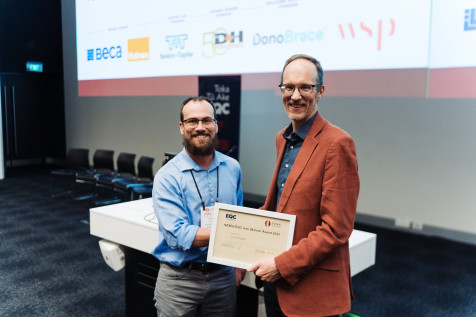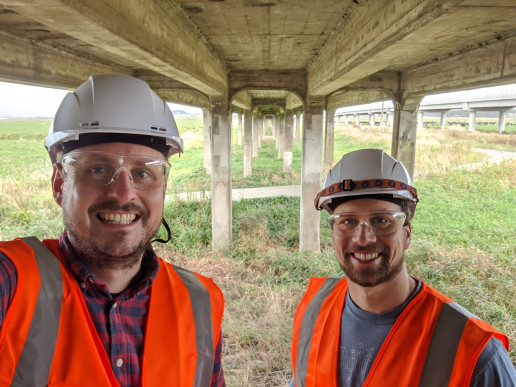Engineer to use prestigious award to further improve building practices
Structural engineering lecturer Dr Lucas Hogan is celebrating winning the prestigious Toka Tū Ake EQC/NZSEE Ivan Skinner award for his natural hazard research which has changed building practices in New Zealand.
Dr Hogan who is a Senior Lecturer at University of Auckland, Waipapa Taumata Rau, was named as the winner at the annual New Zealand Society Engineering Conference for his extensive work in understanding the earthquake risk to buildings and bridges across New Zealand and for helping to change building codes.
Toka Tū Ake EQC Head of Research, Dr Natalie Balfour, says that Dr Hogan’s win embodies the purpose of the award.
“We are familiar with Dr Hogan’s work as Toka Tū Ake EQC funded his research looking into the seismic resilience of bridges(external link). His extensive work is having a direct effect on the engineering industry, which is great to see. This is why we fund the award – to recognise the research that is being put into building earthquake resilience and reducing the impact here in Aotearoa,” says Dr Balfour.

Credit: Smoke Photography. Ken Elwood, Chief Engineer at MBIE and Toka Tū Ake EQC presenting the award to Dr Lucas Hogan at the New Zealand Society Engineering Conference (NZSEE).
Dr Hogan says that aside from the recognition, he’s most excited to be able to use his research to make an impact on the building industry worldwide. The prize money of $10,000 will allow him to share his expertise with peers to shape building guidelines in the USA.
“It’ll help fund the travel costs and fees associated with being a committee member of the American Concrete Institute (ACI) which, among other things, writes the building code provisions on how to design resilient concrete buildings and how to assess the seismic performance of existing buildings.
“I’ll be able to work with some of the best minds in the industry from around the world, to write building codes with new cutting-edge developments and improve the state of practice over there.
“Aotearoa New Zealand and California have similarities with their building codes, so I can use this information to improve guidelines here too.”
Among his portfolio of work, Dr Hogan has helped Waka Kotahi better understand the seismic resilience of bridges across Aotearoa New Zealand and was able to assist with Urban Search and Rescue (USAR) efforts following the Auckland Floods and Cyclone Gabrielle.
In other work, he also helped change engineering practices after highlighting vulnerabilities in the way concrete walls are connected to foundations in common warehouse buildings.

University of Auckland researchers Dr Lucas Hogan, left, and Dr Max Stephens, who used Toka Tū Ake EQC funding to seismic test a decommissioned bridge near Foxton.
The senior lecturer is most proud of his work on the ReCast project he was involved with that led to improved assessment and strengthening of precast concrete floors in Aotearoa. These floors were prolific in buildings from the 1980s and 1990s and used in approximately 80% of multistorey buildings. The research showed that the design would not hold up in an earthquake and the changes in the building code have resulted in a significant improvement for peoples’ safety.
Thanks to the extensive work from Dr Hogan and his colleagues changes are being made to benefit our future, which is one of the biggest motivations.
‘The biggest thing for us as engineers is to keep people safe, build a resilient society and fight the effects of climate change. If we can make buildings more robust, they can either survive earthquakes better or be built back faster, which helps not only reduce our carbon impact, but means people can return to their lives quicker.”